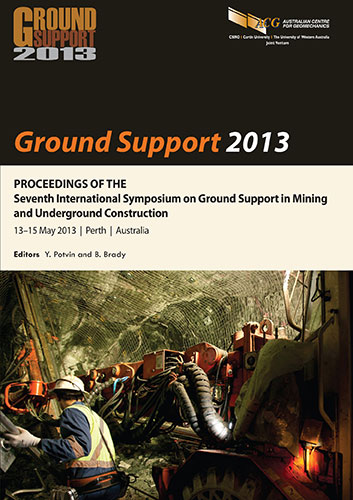Redevelopment support at Northparkes Mines

|
Authors: Brenchley, P; Snyman, LA; Samosir, J; Coxon, B |
DOI https://doi.org/10.36487/ACG_rep/1304_30_Brenchley
Cite As:
Brenchley, P, Snyman, LA, Samosir, J & Coxon, B 2013, 'Redevelopment support at Northparkes Mines', in Y Potvin & B Brady (eds), Ground Support 2013: Proceedings of the Seventh International Symposium on Ground Support in Mining and Underground Construction, Australian Centre for Geomechanics, Perth, pp. 451-460, https://doi.org/10.36487/ACG_rep/1304_30_Brenchley
Abstract:
Northparkes is located 27 km north of the township of Parkes in central New South Wales, Australia. The operations consist of underground block cave mines and an ore processing plant which produces high grade copper and gold concentrate. Production is currently sourced from the E48 Lift 1 block cave mine and open cut stockpiles. Mining commenced at Northparkes in 1994 as an opencut operation. Underground block cave mining began in 1997. Northparkes was the first mine in Australia to use the highly efficient block cave mining method which relies on gravity and natural rock stresses to fragment and recover the ore. The E48 extraction level is located approximately 581 m below surface and consists of 10 extraction drives and 214 drawpoints. Several stress measurements carried out at various levels in both E26 and E48 indicated a low underground regional stress environment and a low to moderate stress state in the E48 orebody. The E48 block used a post-undercut strategy that was initiated in 2009, with production commencing in September 2010 and cave-through to the surface occurring approximately four months later in January 2011. An issue affecting production in 2011 was the stability of the E48 mine. A small portion of the drives on the extraction level began to deteriorate as the ground support system started to fail. The problem was temporarily fixed by stopping production in three extraction drives and tight filling selected areas within these drives (and drawpoints) with low strength concrete. This action provided immediate support and stability whilst allowing time to investigate potential ground support remedies. From these investigations it was decided to use resin injection technology and additional ground support to stabilise the rock in the aforementioned extraction drives as the concrete plug was excavated in a controlled advance and sequence. This made the area safe and ensured the ongoing safe operation of the E48 mine. The re-development of one of these drives began late in 2011, with the remainder to be redeveloped progressively in order to maintain the extraction level stability. This paper looks at the strategies employed to safely re-open previously converged drawpoints and associated extraction drives that were subject to high abutment loading that was possibly associated with premature cave breakthrough.
References:
Peebles, E. (2012) E48 Re-Development Project – Project Execution Plan, Rio Tinto internal document.
© Copyright 2025, Australian Centre for Geomechanics (ACG), The University of Western Australia. All rights reserved.
View copyright/legal information
Please direct any queries or error reports to repository-acg@uwa.edu.au
View copyright/legal information
Please direct any queries or error reports to repository-acg@uwa.edu.au